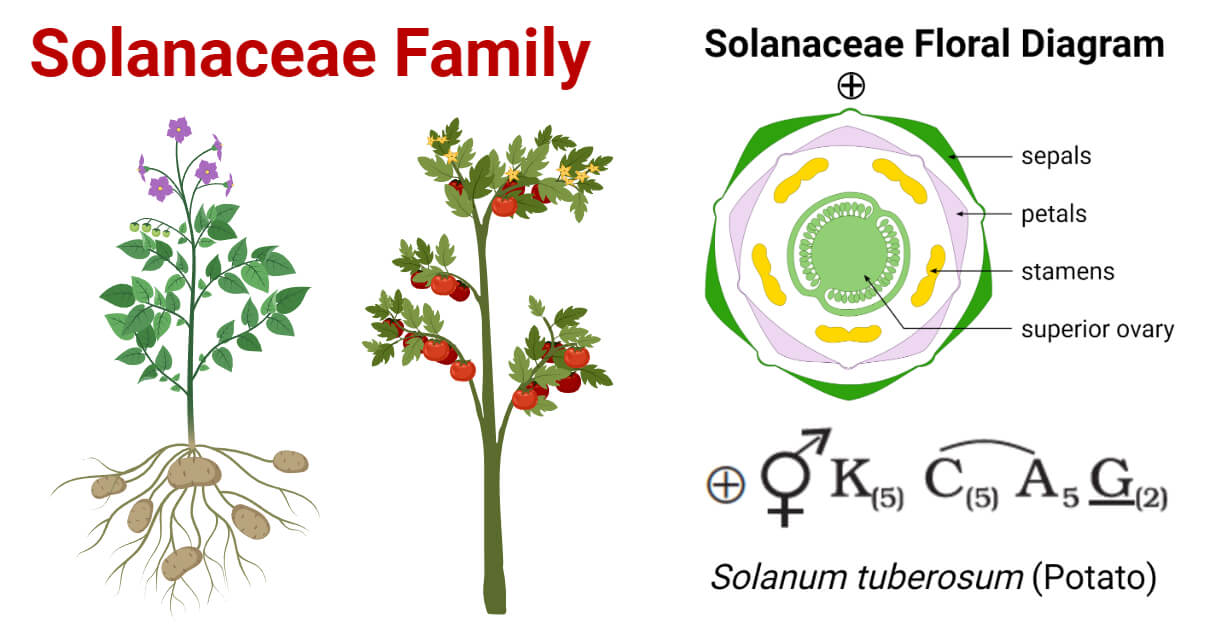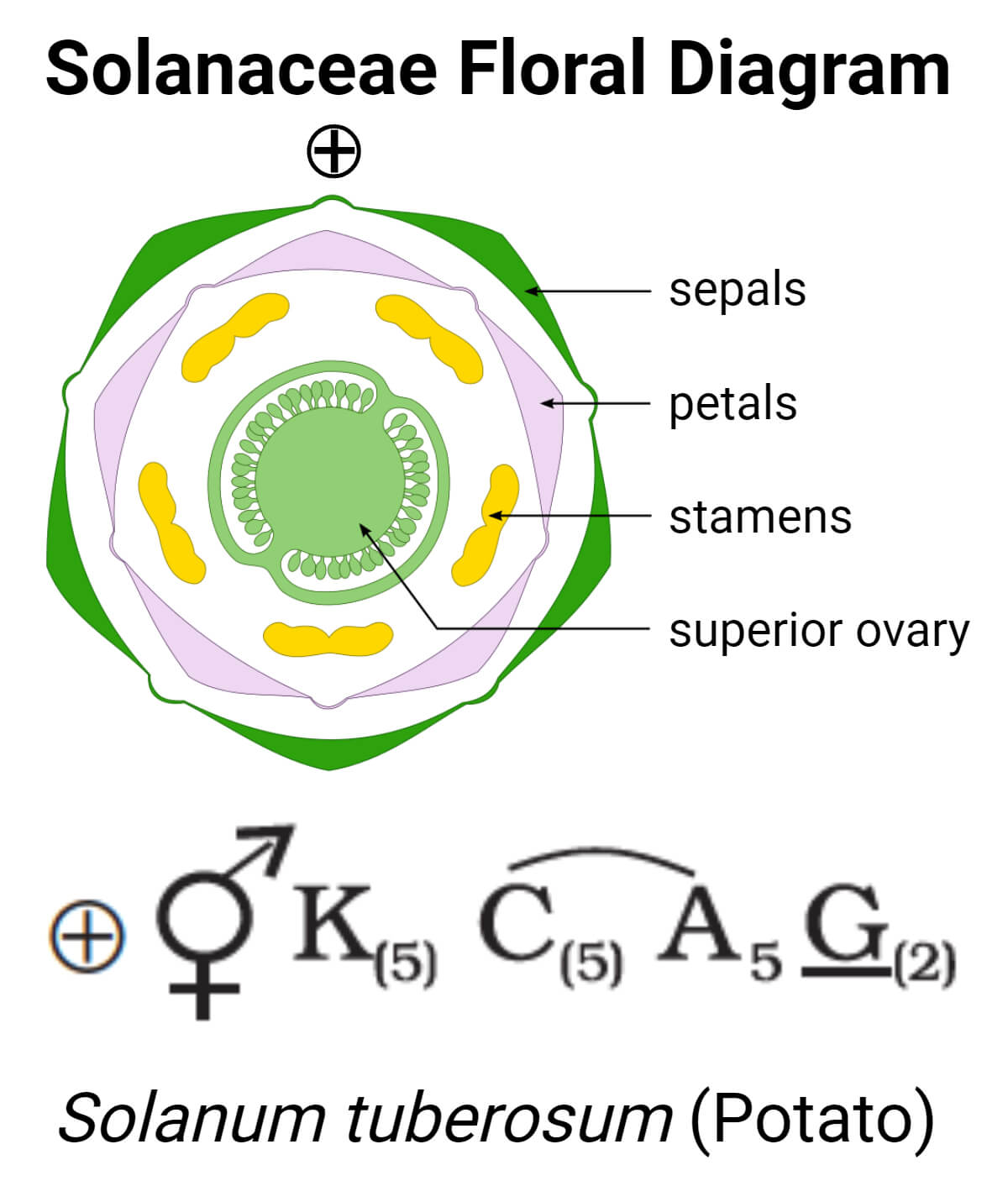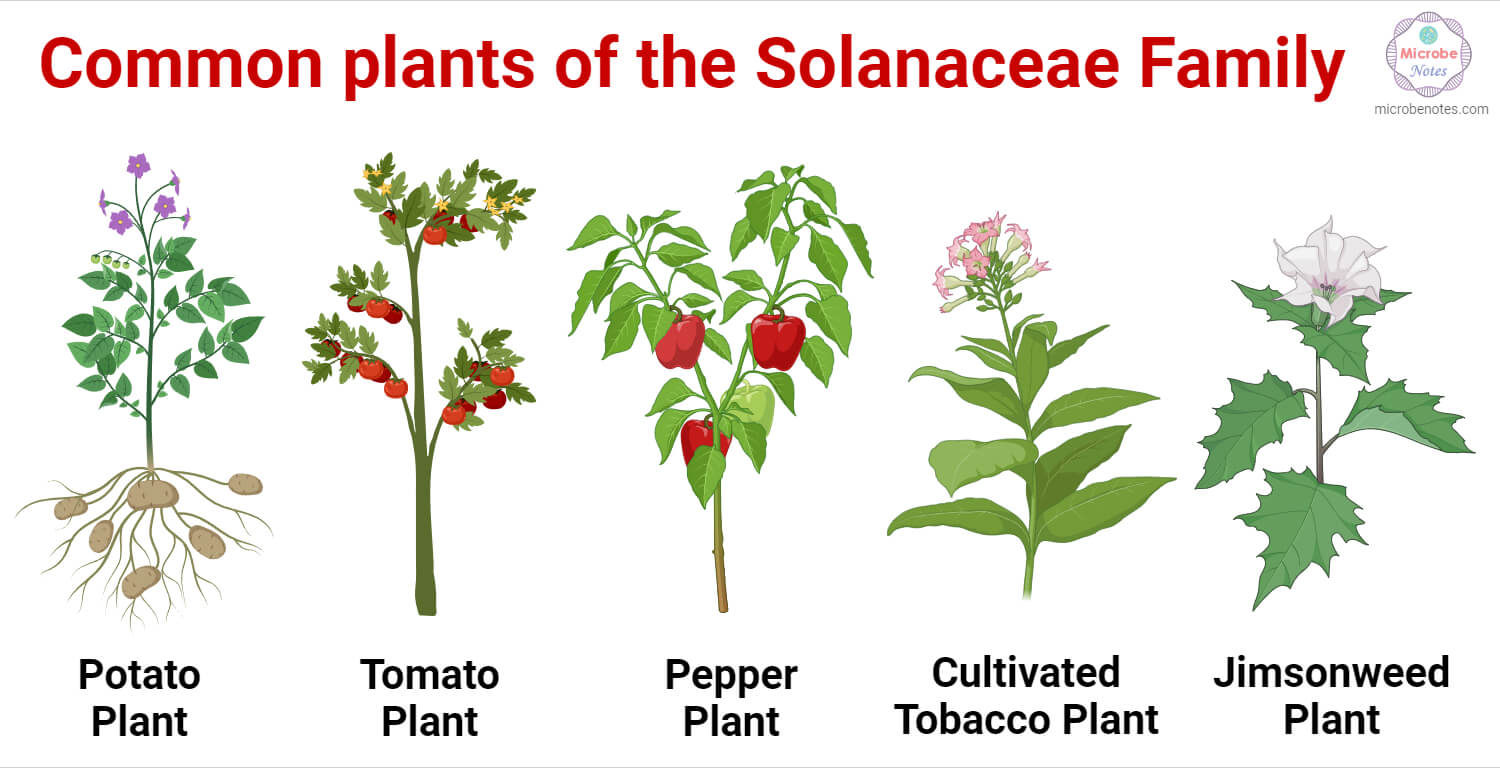- Solanaceae commonly known as Night shade or potato family of flowering plants.
- This family is called nightshade family because many of its plants contains toxic alkaloids, and some species grow in shady area and bloom at night.
- It contains more than 102 genera and 2280 species.
- Out of which about 51 species of 16 genera are reported from Nepal.
- Economically, this family comprises of several plants of food value, medicinal, vegetables and ornamentals.

Systematic Position of Solanaceae Family
| Kingdom | Plantae (Plants) |
| Subkingdom | Tracheobionta (Vascular plants) |
| Superdivision | Spermatophyta (Seed plants) |
| Division | Magnoliophyta (Flowering plants) |
| Class | Magnoliopsida (Dicotyledons) |
| Subclass | Asteridae |
| Order | Solanales |
| Family | Solanaceae |
Distribution of Solanaceae Family
- The members of the Solanaceae family are found throughout the world. However, most of the plants are abundant and widely distributed from tropical to temperate regions.
- Mostly, the plants are mesophytes.
- Certain plants are grown for edible purposes and other various uses.
- The largest genus of this family is Solanum which includes about 1700 species.
- Solanum xanthocarpum shows xerophytic characters.
Habit and Habitat of Solanaceae Family
- The Solanaceae family exhibits diverse habits including annual or perennial herbs, shrubs, and climbers.
- The plants belonging to this family can be found in various habitats including tropical rainforests, temperate woodlands, grasslands and desert regions.
- Terrestrial, mesophyte, wild or cultivated
Vegetative characters of the Solanaceae Family
- Root: The root system consists of a main tap root along with additional lateral branches.
- Stem: Erect, herbaceous,solid or fistular, cylindrical, branched, glabrous or slightly hairy, stem modified into tuber (Solanum tuberosum), Solanum xanthocarpum has spiny stem.
- Leaf: Cauline and ramal, alternate, petriolate or sub-sessile or sessile, exstipulate, reticulate, unicostate venation, mostly simple, hairy.
Floral characters of the Solanaceae Family
- Inflorescence: Cymose type, solitary terminal (Datura) or solitary auxiliary (Petunia), panicle or a typically axillary cyme or extra axillary cyme
- Flower: Bisexual, complete, ebracteate, actinomorphic, cyclic
- Calyx: Sepals five, gamosepalous, imbricate or valvate aestivation, inferior, five-lobed or toothed
- Corolla: Petals five, gamopetalous, twisted or valvate aestivation, inferior
- Androecium: Stamens five, polyandrous, epipetalous, alternate to petals, anther dithecous, basifixed, introrse, inferior
- Gynoecium: Carpels two i.e. bicarpellary, syncarpous, bilocular, axile placentation, ovary superior and obliquely placed, single style, stigma bilobed or capitate
- Fruits: Capsule (Datura) or many seeded berry (tomato)
- Pollination: Cross, entomophilous
- Seed: Albuminous or endospermic embryo is curved or straight, two cotyledons
Floral Formula of Solanaceae Family

| ⊕ | Actinomorphic (radial symmetry) |
| ⚥ | Bisexual |
| K(5) | Calyx – 5 sepals, gamosepalous (united) |
| C(5) | Corolla – 5 petals, gamopetalous |
| A5 | Androecium – 5 stamens, polyandrous (free), epipetalous (attached to petals) |
| G(2) | Gynoecium – bicarpellary, syncarpous (united), superior ovary |
Floral Diagram of Solanaceae Family

Economic Importance of Solanaceae Family
- Vegetables: The plants belonging to this family are consumed as vegetables all around the world such as tomato, potato, capsicum, eggplants, etc. Fruits of Solanum melongena, Capsicum annuum, Lycopersicum esculentum, and stem tuber of Solanum tuberosum are used as vegetables.
- Medicines: Plants of this family have many medicinal uses that are used to treat various disorders. Dried leaves, stem and roots of Atropa belladonna yield atropine which is used to relieve pain. The dried leaves and roots of Datura metel are used in treatment of asthma.
- Food: The member of Solanaceae family are used as food. Potato, Tomato, Brinjal, etc. are used as important vegetables. Physalis manima (sun berry) and Physalis peruviana (Cape gooseberry) are cultivated for their acid sweet edible berries.
- Narcotic: The plants of this family such as Nicotiana tabacum and Nicotiana rustica produce nicotine which is used in tobacco and cigarettes. The poisonous alkaloid stamonine is obtained from Datura stramonium. The seeds and leaves are narcotic and sometimes used for criminal poisoning.
- Condiments: The fruits of Capsicum are used as condiment.
- Ornamental purpose: They are used as ornamental plants to decorate our homes and gardens. Petunica nyctaginifolia, Cestrum diurnum, Cestrum nocturnum and Cestrum elegans are grown in gardens as ornamental plants.
- Others: The economic values of the plants belonging to Solanaceae are limited not only above activities. They can be used to produce industrial products such as ethanol, syrup, dextrin, etc. Some of the plants like Nicotiana tabacum is used as pesticides and insecticides. Also, it can be used in paints and varnishes.
Identifying Characteristics of the Solanaceae Family
- The plants are mostly annual herbs, rarely trees.
- The leaves are simple, alternate in the vegetative parts but opposite near the inflorescence, exstipulate, reticulate.
- Inflorescence is cymose type – mostly axillary or extra-axillary cyme, sometimes solitary or axillary.
- Flowers are ebracteate, actinomorphic, complete, bisexual, pentamerous, hypogynous.
- Calyx consists of five sepals, gamosepalous, persistant and often enlarged in fruit.
- Corolla consists of five petals, gamopetalous, and of various shaped twisted or valvate aestivation.
- Androecium consists of five stamens, polyandrous, epipetalous, alternate to petals, anthers dithecous, basifixed and introrse.
- Gynoecium is bicarpellary, syncarpous, bilocular with many ovules on swollen placenta, axile placentation, ovary obliquely tilted, style long, stigma bilobed or capitate.
- Fruit is a berry or a capsule.
- Seeds is endospermic.
Some common plants of the Solanaceae Family

- Red pepper Capsicum annuum
- Tomato Lycopersicum esculentum
- Brinjal Solanum melongena
- Potato Solanum tuberosum
- Tobacco Nicotiana tabacum
- Belladonna Atropa belladona
- Black nightshade Solanum nigrum
- Stramonium Datura stramonium
- Aswagandh Withania somnifera
- Night Jasmine Cestrum nocturnum
- Day Jasmine Cestrum diurnum
- Thorn apple Datura metel
References
- Keshari A.K, Ghimire K.R, Mishra B.S, Adhikari K.K (2012), A Textbook of Higher Secondary Biology, Vidyarthi Pustak Bhandar, Kathmandu, pp 470-473.
- https://study.com/academy/lesson/solanaceae-overview-examples-facts.html
- https://ocm.govtsciencecollegedurg.ac.in/Document/407_073855.pdf
- https://www.britannica.com/plant/Solanaceae
- https://collegedunia.com/exams/floral-formula-of-family-solanaceae-diagram-and-scientific-classification-biology-articleid-4240
- https://www.askmattrab.com/notes/38-Family-Solanaceae
- https://books.google.com.np/books?id=mnGS2ZE6iA0C&printsec=frontcover&source=gbs_ge_summary_r&cad=0#v=onepage&q&f=false
- https://www.ecobiohub.com/angiosperm-plant-families-and-floral-formula/
- https://www.sciencedirect.com/topics/agricultural-and-biological-sciences/solanaceae
- https://www.sciencedirect.com/topics/pharmacology-toxicology-and-pharmaceutical-science/solanaceae
- https://www.gardenersworld.com/how-to/grow-plants/plant-families-solanaceae/

stamens are five actually.
Thanks, there was a slight mistake on one place, we corrected it, thanks 🙂